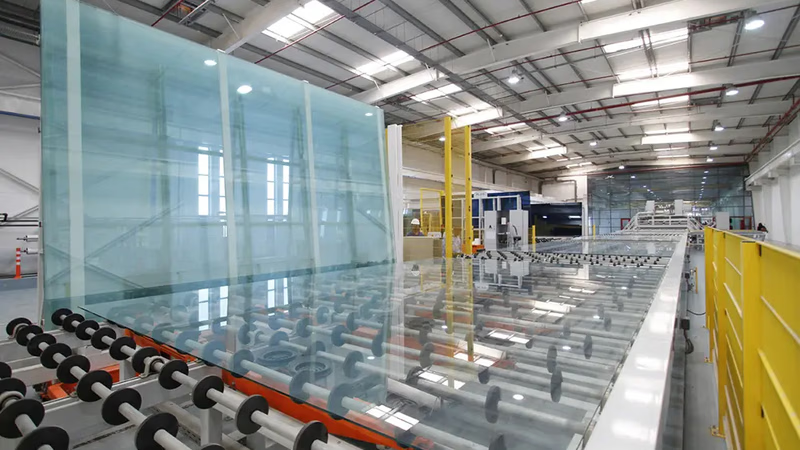
Glass export strategies in Middle East trade platforms.
Before entering the glass export market, it is important to explore the various markets and conduct thorough research on demand, competition, pricing, and customer needs. Accurate and comprehensive information about target markets, competitors and target customers enables you to design the correct strategies. Based on market research, determine the appropriate marketing strategy. This includes selecting target markets, determining competitive advantage, pricing, using appropriate distribution channels, advertising and promotional activities, and customer communications. The marketing strategy should be adapted to the characteristics and needs of the market.
In the global glass market, quality and innovation are very important. Investigating and improving production processes, using high-quality and up-to-date materials, and using advanced technologies will help you produce quality glasses with special features. Innovation in designing, shaping and using glass in different industries plays an important role in attracting customers and competing with other manufacturers. The most important target markets for glass exports are:
- The European Union market, as one of the largest consumer markets in the world, includes the member states of the European Union. In this market, there is a demand for various glass, including construction glass, automotive glass, and glass containers.
- The American market, with its high population and various industries, has extensive needs for glass. This includes building glass, automotive glass, glass containers and other glass products.
- China, with its high population and abundant industrial development, is a large market for glass exports. There is demand in this market for building glass, automotive glass, and other glass products.
- The Indian market is also an attractive market for glass exports with a high population and diverse industries. Also, India has a high demand for construction glass, glass kitchenware and other glass products.
- With the rapid development of civil engineering and construction in the Persian Gulf countries, the demand for construction glass, decorative glass products and automobile glass is increasing in this region.
- Developing markets such as Brazil, Russia, India and African countries with high population and economic growth offer good opportunities for glass exports.
- In addition to the above markets, many other countries can be attractive export markets for glass, such as Canada, Australia, Mexico, Japan and other European countries.
In the global glass business, building long-term relationships with customers and business partners is very important. Providing after-sales services, flexibility in production and supply of products, continuous and effective communication with customers and compliance with contractual obligations are the most important factors that make you successful in the global market. To grow and develop in exporting glass to the global market, business skills such as financial management, supply chain management, communication and negotiation skills, technology transfer and risk management are very important. Strong business skills will empower you to succeed in the global glass market.
In exporting glass to global markets, it is necessary to follow the laws and regulations related to export, international trade and industrial standards. Make sure that your products meet international standards and that you have the necessary licenses and documents for export. Joining and collaborating with organizations and associations related to the glass industry can help you access market information, network with industry professionals, and increase your credibility and credibility. Organizations and associations such as the Glass International Association and the Glass Manufacturing Industry Council are among the recommended organizations.
In the production and export of glass, product quality inspection is very important before shipping. Ensure that your glass products meet quality and safety standards to maintain customer satisfaction and reduce post-sale problems. The glass industry is prone to research and development and needs innovation and technological advances. Investing in research and development makes it possible to improve processes and products, reduce costs and increase quality, helping you attract new customers and compete with other manufacturers.
-

China leads the global glass industry as the largest producer and exporter, with major companies like China Glass Holdings and Fuyao Glass Industry Group. The United States follows closely, featuring prominent firms such as Owens-Illinois and Corning Inc. Japan, Germany, India, and Italy also play significant roles in glass production, with companies like AGC Inc. , SCHOTT AG, and Asahi India Glass Limited contributing to their respective markets. Key raw materials for glass manufacturing include sand, soda, and sodium carbonate, with China being a major supplier of sand and gravel. The U. S. also has substantial reserves of these materials in states like California and Oregon.
Countries like Russia and Brazil are noted for their rich deposits of sand and gold essential for glass production. Germany is recognized for its technological advancements in producing high-quality glass products, while Japan is known for its innovative methods that yield glasses with exceptional clarity and durability. Sweden and the Czech Republic are also renowned for their artistic glass production, emphasizing craftsmanship alongside technology to create unique designs. The global landscape of the glass industry showcases a blend of traditional craftsmanship and modern technology across various regions.
-

Iran, Turkey, Saudi Arabia, Iraq, and Egypt are key players in the West Asian glass market, producing a variety of glass products including construction and automotive glass. These countries benefit from abundant natural resources like minerals and sand, enabling cost-effective production. The region"s strong domestic demand is driven by rapid industrial growth and construction activities. Investments in advanced production technologies have enhanced productivity and reduced costs, while also focusing on export markets to boost global competitiveness. Innovations such as thermal insulation and anti-theft glass have emerged, improving energy efficiency and safety. Despite facing challenges related to raw material quality and production standards, the Middle East"s glass industry is evolving through research and development efforts aimed at enhancing product performance. As manufacturers continue to adopt modern techniques, the region is poised to compete with established global players in terms of quality.
-

Entering the glass export market requires thorough research on demand, competition, pricing, and customer needs. Understanding target markets and competitors is crucial for developing effective marketing strategies. Key markets for glass exports include the European Union, the United States, China, India, and the Persian Gulf countries. These regions show significant demand for various glass products such as construction glass and automotive glass. Additionally, emerging markets like Brazil, Russia, and African nations present opportunities due to their economic growth. Building long-term relationships with customers is essential; this includes providing after-sales services and maintaining effective communication. Business skills in financial management, supply chain management, and negotiation are vital for success in the global market. Compliance with international trade laws and standards is necessary to ensure product quality and safety.
Collaborating with industry organizations can enhance credibility and provide valuable market insights. Investing in research and development is also critical to innovate processes and products, ultimately attracting new customers.
-

Glass is a vital export product utilized across various industries, including construction, automotive, packaging, and electronics. The global demand for high-quality glass presents significant export opportunities for manufacturers. Successful exporters must focus on producing quality glass and setting competitive prices to attract foreign markets. The trade can occur through direct exports or intermediary channels, with shipments typically made via container loads or sea freight. Innovation in product offerings is crucial; manufacturers who develop unique glass types can enhance their competitiveness. Various forms of glass are traded internationally, including industrial glass for construction and automotive uses, decorative glass for interior design, mirror glass for reflective surfaces, neon glass for advertising, and packaging glass for consumer goods. The diversity in shapes and sizes of glass products facilitates numerous transactions across different countries and industries. Factors such as economic growth and industry demands significantly influence the volume of global glass trade. For precise data on the current state of the glass trade market, consulting authoritative sources like the WTO or OECD is recommended.




